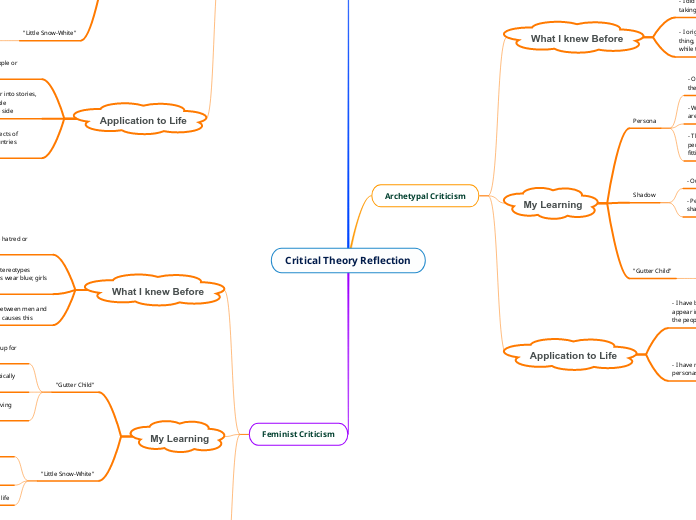af Rachel Street 2 år siden
170
Critical Theory Reflection
The text delves into the author's reflections on archetypal criticism, highlighting the distinction between archetypes and tropes and the newfound understanding gained from a course.

af Rachel Street 2 år siden
170

Mere som dette
- Snow-White had no power to control her own life
- Snow-White was easily taken advantage of by multiple characters in the fairy tale
- This fairy tale made it seem like girls were just innocent creatures that are only valued for their beauty
- As a result, girls make much less money than men, giving them a huge disadvantage and lack of power
- Girls are forced down career paths that are stereotypically feminine, such as housekeeping and kitchen work
- In this novel, the society has been built to set women up for failure
This fairy tale by the Grimm Brothers does not explicitly talk about colonization, but I was able to apply post-colonial criticism to the story and extract an underlying message from it. This story taught me about how people in power dominate over others by using tactics of dehumanization.
This poem by Jeanette Armstrong tells the story of colonization in Canada from an Indigenous point of view. It reveals the devastation that colonization actually caused for the environment, animals, and Indigenous people. This poem gave me an understanding of how it feels for the colonized to have their whole lives stripped away from them.
In this novel by Jael Richardson, there are two groups of people: Gutter people, who are colonized, and Mainlanders, who are the colonizers. Different characters from the two backgrounds share their perspectives on how their society has been shaped into the way it is. The Mainlanders, who have won all the power, feel like what they did was for the greatness of the country, but when I see the negative effects that the Gutter people have to live with as a result, it is clear that colonization only benefits the colonizers.
- I am able to recognize and understand that the fear of not being accepted in society is what drives most people to hide their insecurities (shadow) and display a more likeable persona on social media
- for example, my parents represent the archetype of caregivers as they are both compassionate, nurturing, generous, and providing towards me
In this novel, the main character is pregnant with a baby. Deep down in her shadow, she knows that she wants to keep this baby and be a nurturing caregiver to it. However, she must put on a mask and pretend that she wants nothing to do with the baby, otherwise it will be taken away from her too soon.
- People often do not like who they are and will hide their shadow either unconsciously or on purpose
- Our shadows are who we truly are inside
- These masks are used as safety blankets to hide our real personalities, possibly out of fear of being rejected or not fitting in with others
- We often put on "masks" which are different personas that are not true to our character
- Our personas are the images that we consciously present to the world